Mapping Methodism – Carfury Bible Christian Chapel, Carfury, Newmill, Penzance
Categories Mapping Methodism, Projects2 Comments
Carfury is a hamlet in west Cornwall situated three miles northwest of Penzance. It is in the parish of Madron. According to William Morris, nearby Newmill has been known by various names in records including Mulfra, Crankan and Higher Crankan. Higher Ninnes, Crankan and Trythall are all very close to Newmill. The Glossary of Cornish names written by the Rev John Bannister, LLD, vicar of St Day, says Carfury means ‘The camp on the hill’. This profile of Carfury Bible Christian Chapel has been compiled by Val Thomas of St Ives Old Cornwall Society with help from William A Morris, also a member of St Ives Old Cornwall Society.
The new Chapel built 1832? – 1971 (Images: Val Thomas. April 2021)
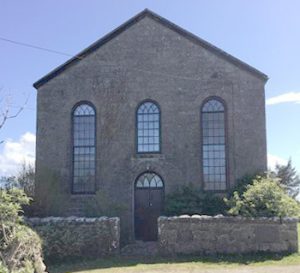
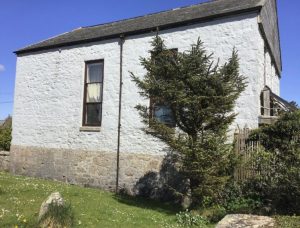
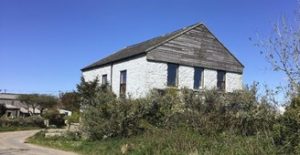
Elizabeth Carne, an heiress and geologist from Penzance founded several schools in the area, including one at Carfury. (It isn’t actually in the hamlet, but a short distance away.)
1811 In his book, ‘What Mean these Stones’, John Horner says: “The story of the building of Carfury is associated with the person of a layman much loved and respected in the first half of the Nineteenth Century – John Bennetts. At the age of 15, with his parents, he attended the Wesleyan Chapel at Gear, which is still to be seen on the road from Carfury to Gulval. From his early years John was aware of the need for salvation and forgiveness of sins. On the 20th April 1811, at the age of 21 and in Gear Chapel during a sermon preached by a Mr. John Berryman he received ‘the witness of the spirit’ that his sins were forgiven and he cried out aloud in the chapel’ Praise God. The Spirit answers to the blood and tells me I am born of God!’” In 1812 he started a prayer meeting at Carfury. Shortly afterwards he was taken seriously ill. Not long after his recovery, the Bible Christians began preaching in the area. He and other members of his prayer group joined them and this was the beginning of the church at Carfury, which eventually settled in 1832.”
1817 The congregation was already gathering at Carfury in 1817, according to the editor of the Cornishman newspaper, Herbert Richards. He said in an article dated Thursday June 2nd 1938 that “an old Penzance Wesleyan Circuit plan dated 1817 has on it the following preaching places: Penzance, St Just, St Ives, Mousehole, Newlyn, Marazion, The Mount, Ludgvan, Treve, Buryan, Brea, Sancreed, Towednack, Lelant, Morvah, Bosullow, Zennor, Sennen, Sawah, Geer-stamps, Gulval, Madron, Carfury, Tregavara”.
The Old Sunday School was the original chapel – built 1821
(Images: Val Thomas April 2021)

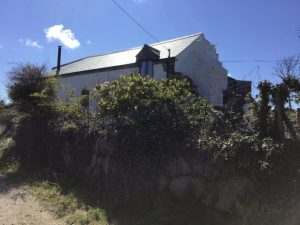
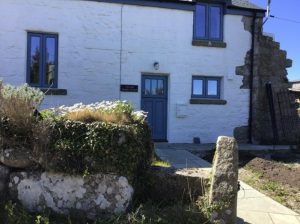

1821 The Carfury Bible Christian Chapel was founded with seating for 172 persons.
Google states c1821 – 1970.
1832 There is mention in ‘What Mean these Stones’ of a chapel being opened in Carfury. Could this be the opening of the new, more spacious building across the road? The Centre, Newlyn lists the chapel as 1833. West Penwith Resources also says the chapel started in this year with seating for 172.
1839 The Sunday-school was started according to a Cornishman article dated 16th July 1931 saying it was the ninety-second anniversary.
1843-4 There was revival at Carfury in the winter, as a result of which ‘it was claimed that nearly all the respectable people of the neighbourhood were converted’. Rev. Thomas Andrews conducted the special services at Carfury which were attended by hundreds of people. Among those attending were: W.H. Hosken, Edward Hosken, William Rowe and Henry Brush who all gave their lives in Bible Christian Ministry.
1847 Death in Australia. W. H. Hosken, who had been converted when 17 years of age, in 1843, at Carfury, entered the Bible Christian Ministry. He had been born in 1821, the same year as the first Bible Christian Home Mission was established. His father had been killed at Ding Dong mine while he was a boy so the mine made him an apprentice blacksmith in the shop belonging to the mine. He was converted at the age of 17 and at once, began to work for God. For 14 years he laboured in the old land. In the year 1861 he was appointed to Victoria until 1886 when he became superintendent and moved to other appointments. He died in September 1907, in Australia, according to the Cornishman, September 19th.
1851 John Bennett, Henry Brush and Edward Hoskin were the elders according to William Morris.
Elizabeth Carne was the Aunt of Charles Carne Ross who was a prominent banker and philanthropist in Penzance. He was instrumental in building the connecting road from the station to the Barbican in Penzance and the bridge installed is still called the Ross Bridge. Her father, Joseph Carne, founded the Methodist school in Chapel Street which later became the West Cornwall Wesleyan School based in York House, Penzance.
The school she founded was later taken over to be a mission room.
Elizabeth Catherine Thomas Carne, 1820- 1873, was a Cornish geologist, philanthropist, conchologist, financier, banker, natural philosopher and mineral collector. She was the fifth daughter of eight children born to Joseph Carne and his wife, Mary Thomas Carne. Her home in Rivere House, Hayle welcomed such people as Humphry Davy into the laboritory.
Her grandfather and father were staunch and active class leaders and the Methodist book room was lodged in their home. Elizabeth was educated at her next home in Chapel Street, Penzance, by her parents. On her father’s death in 1858, having inherited an ample fortune, she a lot on charitable causes such as St Paul’s school. She also founded schoools at wesley Rock, Heamoor, Bosullow and Carfury. A museum was also built to house her ample collection of minerals. She was head of the Penzance bank from 1858 to her death in 1873.
1859 The Band of Hope was set up according to a Cornishman article dated 1937 saying it was the 78th anniversary in February of that year. However, another article dated 11th February 1904 said it was the 48th anniversary, which would make the start-up 1856?
1866 New chapel built with the previous one becoming the Sunday school.
1871 The Royal Cornwall Gazette, Saturday September 30th: Gulval School Board. All children in the parish of Gulval between the ages of 5 and 12 will have to attend school. There is sufficient school accommodation at Gulval for those children on the lower side of the parish, but on the higher side 150 children will need to have provision made. ‘Of this number Miss Carne’s school at Carfury, when certified by the Government Inspector, will take about 50, leaving say 100 still to be accommodated. Out of the 380 children in the parish of Gulval who are stated in the report as requiring accommodation, no less than 124 are returned by their parents as “neither employed in labour nor attending school”.’
1877 It appears by studying the map that at this time there were paths but no recognisable road to the hamlet.
1879 Wednesday November 12th, The Cornish Telegraph: …In the evening the Carfury Chapel re-opened its bazaar and the attendance was good…’
1880 The Cornish Telegraph, Wednesday July 4th. ‘The forty-first anniversary of Carfury Bible Christian Sunday-school was held on Saturday and Sunday last. On Saturday the teachers and scholars numbering in all 117, assembled at the schoolroom at half-past two, formed in procession, and with the band of the 13th D.C.A.V.(St Just) in attendance, proceeded to the beautiful grounds at Trevaylor………… The weather was all that could be desired, and the congregations good, nearly six hundred persons being present at the evening service……’
1881 The Cornishman newspaper: Thursday March 17th.’A religious awakening has, during the past week, been notified in the little village of Carfury, upwards of 60 young persons from the neighbourhood having professed to their being converted.’
1882 Apparently, according to Mr Lutey in a meeting, there was a room at Carfury which would hold 400, if it were wanted; also a chapel accommodating 200. The Cornish Telegraph, Thursday June 8th: – “At the Bible Christian Chapel, Carfury, we have 65 accredited members meeting in class, 132 teachers and scholars at Sunday-school and upwards of 200 persons in all who attend public worship…..”– Richard Dale.
1884 The Cornish Telegraph, Thursday 24th April: ‘Mr J. T. Chappel, master of the National School, Zennor, was elected master of the school at Carfury, in succession to Mr J. H. Barkell, who has obtained a valuable appointment under the Queensland Government.’
A new mission chapel was about to be built at Carfury by Mrs John Bolitho, on a site given by Mr T.S. Bolitho. This was later called All Saints, Trythall and was designed by J.P. St Aubyn. It is next to Trythall school and now abandoned.
1885 The chapel had a harmonium according to the Cornish Telegraph, November 5, 1885. They also had a Band of Hope. The gallery was filled as were the pews. (So it had a gallery too.)
1889 Thursday July 18th – ‘The Jubilee of the Bible Christian Sunday School, of Carfury, was celebrated on Saturday and Sunday. On Saturday afternoon the children and officers met in the old chapel, now used as the schoolroom, and headed by the Newbridge brass band paraded the immediate vicinity. On returning they were photographed in groups, in front of the ancient edifice, after which the children were regaled with tea and buns “… The school consisted of 84 scholars and officers, and the funds well sustained. The choir assisted and the chapel was crowded on Sunday evening.
1891 The population was decreasing and in the census only 21 people, including 7 unemployed children are listed as living in the hamlet, with the unoccupied chapel.
1894 Teachers were fined for being late or absent, the highest fine being 3d. Mr Lutey said this brought good results.
1903 Mr Tom Daniel, who was born at Carfury preformed at the Chapel. He had been a member of the Carfury Bible Christian choir….. Mr Tom Penglaze was the organist.
The Cornishman, Thursday September 24th: ‘Carfury Bible Christians held their harvest festival on Sunday. In the afternoon the Madron Wesleyan choir gave a service-of-song. The chapel was filled to overflowing….’
1904 10th November – The Cornishman money had been raised for Carfury Sunday-school.
1905 On 6th July, The Cornishman newspaper announced that Carfury had spent £30 in renovation, the whole amount being raised.
1907 The Chapel was now known as Carfury United Methodist Church on the amalgamation of various chapels.
1911 4th May Carfury Brass Band under the conductorship of Mr William Giles advertised to play for future events.
1914 – 1918 According to William Morris nearby “All Saints Church, Trythall, was closed during the First World War and the local people then attended Carfury United Methodist Chapel, originally a Bible Christian Chapel built in 1833 for a congregation of 172. Edward Lutey was the local preacher at Carfury and arranged all the activities there. The main ones were outings and teas. The Band of Hope outing took place in June or July.”
1917 John Hosken Christopher, a Lieut. In the Indian Army, was killed in action in Mesopotamia aged 27. A plaque in his memory is now on the wall of the chapel which he attended as a child and requested to have put in place as a memorial.
1919 The Cornishman and Cornish Telegraph, Wednesday October 8th: ‘The United Methodist Church at Carfury was re-opened after thorough renovation on Friday last…..Miss Bennett was at the harmonium…. The renovation cost £100…… ‘
1920 The Cornishman and Cornish Telegraph Weds March 17th:- At the Quarterly meeting of the High-street U.M. circuit it was reported that Carfury and Drift chapels had been renovated. According to a report in the Cornishman and Cornish Telegraph, Wednesday 12. 1921: “Some months ago it became necessary to renew the roof of the Sunday school and renovate it at a cost of £95. …. The total raised was £90 so that very nearly wiped out the whole cost of the debt.”
1920s This report is from William Morris, a St Ives Old Cornwall member. Ivy and Eileen Osborn (as they were then) of Newmill told him about the Sunday School tea treats of their childhood “These were organised by Herbert Lutey, the local preacher of Carfury Chapel and took place in a nearby field. Tables and forms were set out and parents and children walked in their best clothes from the villages around to the field. The general festivities began with the children playing the then popular children’s game called ‘Kiss in the Ring’ to get warmed up. Various other games would be played before tea was organised at six o’clock in the late afternoon when the parents ate a cream tea on the tables and the children drank tea and ate feast buns on the grass.” He also says “At Christmas there was a party in the big chapel hall opposite the chapel. A member of the congregation dressed up as Father Christmas and handed out books to the children as presents together with certificates for good attendance. Isobel Baillie sang in the chapel according to Priestland. He also says that the chapel has ‘ingeniously been adapted as a workshop below and, above, a flat of the most glorious aspects and considerable comfort.’
1938 The Cornishman and Cornish Telegraph, Thursday December 1st.- There was a ‘Gale in the West’. ‘It was 2 o’clock in the morning when the gale was at its height, that the occurrence happened, and it was fortunate for them that the consequences were not worse than they actually were. The house in question is Trythall Cottage, New Mill, occupied by Mr William Henry Roberts, his wife and son. They were awakened by a terrible crashing noise and on coming downstairs found that practically the whole roof had been swept away.’ …’ The damage to this building and to the old chapel where Billy Bray preached is estimated at from £700 to £800. Several outhouse roofs on Mr Edward Lutey’s farm have been torn away’. Apparently this was the worst storm in living memory and must have left the congregation with nowhere to gather: Hence the comment about meeting in the Newmill schoolroom in the excerpt.

1939 Thursday March 30th. Mr C. V. Thomas, St Ives M.P. said “The real saints of Cornwall are the men and women whose lives are never written, who lived unknown except in their own locality, but who are the salt of the earth”. He was opening the re-dedicated Carfury chapel, Gulval, on Friday afternoon. The opening ceremony was preceded by a luncheon in the old chapel – now a schoolroom – where Billy Bray is said to have preached. Apparently when they were without a home Rev. Buckley offered every one of them a home in the Church of England schoolroom at Trythall. The key to open the chapel was presented by Mrs Mary Bennetts, who was born and bred at Carfury, and is now home from the U.S.A.
1941 – 1946 The Cornishman newspaper mentions many events taking place at Carfury Methodist Church: chapel anniversary, Mr Allen waking there Sunday evening services etc.
1945 on the 30th August the position of an organist was advertised.
1948 The Cornishman September 2nd advertised that ‘Carfury Methodist Church was re-opening after renovation on Friday September 3rd. Tea at 5pm, Re-opening at 7pm.’
1971 The building was sold and purchased to be transformed into a studio and home.
 Carfury 2021. Map: Cornwall interactive mapping. The Old Sunday School was the original chapel.
Carfury 2021. Map: Cornwall interactive mapping. The Old Sunday School was the original chapel.
2021 Kresen Kernow resources:
Resources:
Wikipedia Carfury
The Centre Newlyn Trinity Methodist Church.
‘Home in the West’ – Priestlands’ Cornwall
William Morris’ research and recollections of life in Newmill.
National maps of Scotland.
‘What mean these stones’ – John Horner.
The Hosken family research – Hosken.net
My United Methodists. –myunitedmethodists.org.uk
William A. Morris – recollections of life in the village of Newmill in his youth
Find my Past newspaper articles
west-penwith.org.uk Chapels in Penwith

I enjoyed reading your article on Carfury Bible Christian Chapel. John Bennetts was my 3 x great grandfather and some years ago I found a copy of his Memoir written by W. Bray in the Bible Christian Magazine dated 1832 – 1907 at the Redruth Studies Library in Redruth.
If you would like a copy please let me know and I will email to you. The magazine should be now archived at Kresen Kernow.
Hello Jane, I would love a copy please. My email is vt7846198@gmail.com.
John Bennett is also loosely related to me! His daughter married a Dale from Gear Farm and they had a son called Richard and other children. My maiden name was Dale! It is a tenuous link. But I have found my Dale and Jenkin ancestors feature in many of the chapels of the Madron, Newmill, Zennor area. I always knew Methodism was part of my heritage.
If you have any further info on the chapel or Bennett family I would be very interested.